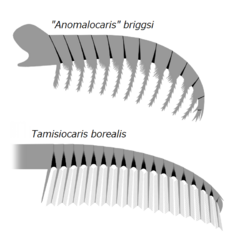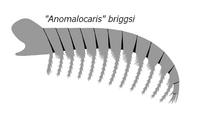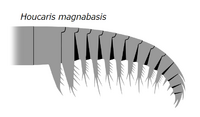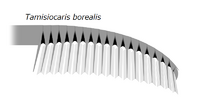Biology:Tamisiocarididae
| Tamisiocarididae | |
|---|---|

| |
| Frontal appendages of Echidnacaris briggsi and Tamisiocaris borealis | |
| Scientific classification | |
| Domain: | Eukaryota |
| Kingdom: | Animalia |
| Phylum: | Arthropoda |
| Class: | †Dinocaridida |
| Order: | †Radiodonta |
| Family: | †Tamisiocarididae Pates & Daley, 2019 |
| Genera | |
| |
Tamisiocarididae is a family of radiodonts, extinct marine animals related to arthropods, that bore finely-spined appendages that were presumably used in filter-feeding. When first discovered, the clade was named Cetiocaridae after a speculative evolution artwork, Bearded Ceticaris by John Meszaros, that depicted a hypothetical filter-feeding radiodont at a time before any were known to exist.[1][2][3] However, the family name was not valid according to the International Code of Zoological Nomenclature, as no real genus named "Cetiocaris" exists, and in 2019 it was formally replaced by the name Tamisiocarididae, after the only valid genus of the clade at the time.[4] The family is only known from Series 2 of the Cambrian, unlike other radiodont families, which persisted longer into the Cambrian. All known species would have lived in tropical or subtropical waters, suggesting a preference for warmer waters.[5]
Description
Like most radiodonts, cetiocarids have spiny frontal appendages. However, in this family the auxiliary spines are fine and densely-arranged, which are modified for use in filter feeding like modern basking sharks and mysticete whales. For example, Tamisiocaris is estimated to have fed on prey roughly a millimeter in size.[1]
Classification
| |||||||||||||||||||||||||||||||||
| Phylogenetic relationships of Tamisiocarididae[1] |
Tamisiocarididae was originally named Cetiocaridae. In the 2013 speculative paleoart book All Your Yesterdays, paleoartist John Meszaros depicted a hypothetical filter-feeding anomalocaridid he named "Ceticaris". This artwork inspired the name of Cetiocaridae.[1] However, as no genus "Cetiocaris" actually exists, the name Cetiocaridae does not comply with article 29 of the International Code of Zoological Nomenclature and is invalid.[6] The family Tamisiocarididae was subsequently devised as a replacement name for the clade.[4] Cetiocaridae was originally defined phylogenetically as all species more closely related to Tamisiocaris borealis than to Anomalocaris canadensis, Amplectobelua symbrachiata, or Hurdia victoria.[1]
| Species | Describers | Year Named | Age | Location | Frontal Appendage |
|---|---|---|---|---|---|
| Echidnacaris briggsi | Nedin | 1995 | Cambrian Stage 4 | 
| |
| Houcaris saron? | Hou, Bergström, & Ahlberg | 1995 | Cambrian Stage 3 | 
| |
| Houcaris magnabasis? | Pates, Daley, Edgecombe, Cong, & Lieberman | 2019 | Cambrian Stage 4 | 
| |
| Tamisiocaris borealis | Daley & Peel | 2010 | Cambrian Stage 3 | 
|
Distribution
Tamisocaridid fossils have been found in the Emu Bay Shale of Australia , Sirius Passet lagerstätte of Greenland, and Kinzers Formation of the United States.[4] Their fossils date to stage 3 and stage 4 of the Cambrian.
References
- ↑ 1.0 1.1 1.2 1.3 1.4 "A suspension-feeding anomalocarid from the Early Cambrian". Nature 507 (7493): 496–9. March 2014. doi:10.1038/nature13010. PMID 24670770. Bibcode: 2014Natur.507..496V. http://dro.dur.ac.uk/21270/1/21270.pdf.
- ↑ "Bearded Ceticaris by NocturnalSea on DeviantArt" (in en). https://www.deviantart.com/nocturnalsea/art/Bearded-Ceticaris-356974867.
- ↑ All Your Yesterdays. Irregular Books. 2013. p. 74.
- ↑ 4.0 4.1 4.2 Pates, Stephen; Daley, Allison C. (2019). "The Kinzers Formation (Pennsylvania, USA): the most diverse assemblage of Cambrian Stage 4 radiodonts". Geological Magazine 156 (7): 1233–1246. doi:10.1017/S0016756818000547. Bibcode: 2019GeoM..156.1233P. https://www.cambridge.org/core/product/identifier/S0016756818000547/type/journal_article.
- ↑ Wu, Yu; Fu, Dongjing; Ma, Jiaxin; Lin, Weiliang; Sun, Ao; Zhang, Xingliang (2021). "Houcaris gen. nov. from the early Cambrian (Stage 3) Chengjiang Lagerstätte expanded the palaeogeographical distribution of tamisiocaridids (Panarthropoda: Radiodonta)". PalZ 95 (2): 209–221. doi:10.1007/s12542-020-00545-4. ISSN 1867-6812. https://link.springer.com/10.1007/s12542-020-00545-4.
- ↑ Van Roy, Peter; Daley, Allison C.; Briggs, Derek E. G. (2015). "Anomalocaridid trunk limb homology revealed by a giant filter-feeder with paired flaps". Nature 522 (7554): 77–80. doi:10.1038/nature14256. PMID 25762145. Bibcode: 2015Natur.522...77V. http://www.nature.com/articles/nature14256.
Further reading
- Jiao, D.-G., Pates, S., Lerosey-Aubril, R., Ortega-Hernández, J., Yang, J., Lan, T., and Zhang, X.-G. (2021). "The endemic radiodonts of the Cambrian Stage 4 Guanshan Biota of South China". Acta Palaeontologica Polonica 66 (2): 255–274. https://www.app.pan.pl/archive/published/app66/app008702020.pdf.
External links
Wikidata ☰ Q16975582 entry
 |

